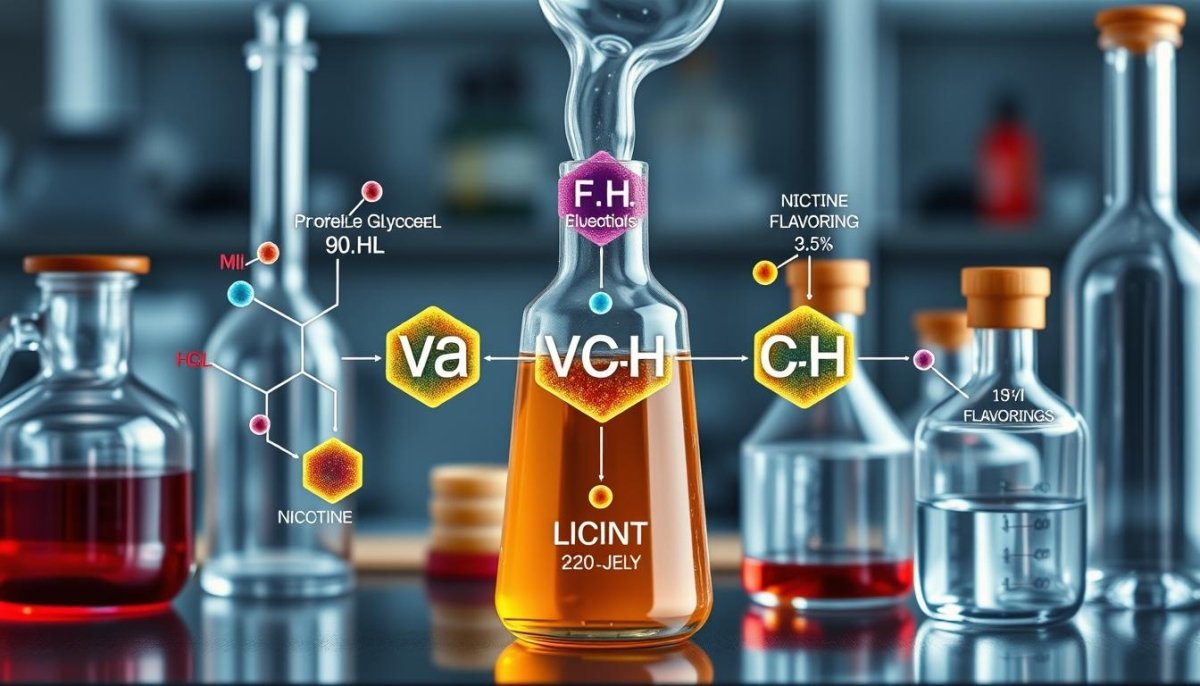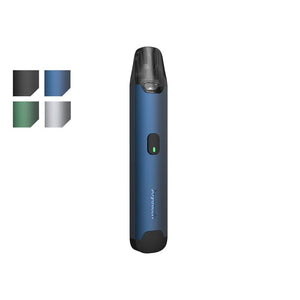Vaping Chemicals: What's Really in Your E-Cigarette?

Vaping Chemicals: What's Really in Your E-Cigarette?
Ever thought about what's in that sleek vape device you're using? Many think it's just flavoured water vapor. But the truth is much more complex and could be risky.
Vaping has become very popular. But research shows there are thousands of unknown chemicals in vape products. Johns Hopkins University found many harmful substances that users often don't know about.
It's important to know what's in vapes for our health. With nicotine levels from 6 to 54 mg/ml, e-cigarettes are not as safe as people think.
Key Takeaways
- Vapes contain thousands of unidentified chemical ingredients
- Nicotine levels vary dramatically across different products
- E-cigarettes are not simply water vapor
- Chemical composition can pose significant health risks
- Consumer awareness is critical for safe usage
Understanding Vaping: An Introduction to E-Cigarettes
Electronic cigarettes have changed how we use nicotine, giving a new option instead of smoking. These devices mix technology with a better user experience.
Vaping compounds have changed how we take nicotine, making it possibly safer. E-cigarettes have several parts that work together for a unique experience.
What Are E-Cigarettes?
E-cigarettes are devices that mimic smoking by heating a liquid into a vapour. They come in many styles, each for different tastes:
- Disposable e-cigarettes for one-time use
- Refillable vape pens with customisable options
- Advanced mod systems for experienced users
- Pod systems with convenient nicotine salt delivery
How Do E-Cigarettes Work?
E-cigarettes work by heating e-liquid to make a vapour. This vapour carries nicotine and flavours.
| E-Cigarette Generation | Key Characteristics |
|---|---|
| 1st Generation | Disposable devices with basic functionality |
| 2nd Generation | Refillable cartridges and separate battery pens |
| 3rd Generation | Customisable tanks and mods with advanced features |
| 4th Generation | Pod systems with nicotine salt technology |
Clinical research suggests e-cigarettes are 95% less harmful than traditional tobacco products, making them a safer choice for nicotine users.
The development of e-cigarettes has been impressive. New technology lets users control nicotine levels and enjoy a more tailored experience.
The Basic Components of Vape Juice
Vape juice, or e-liquid, is a mix of ingredients that makes the vapour for e-cigarette users. Knowing what's in vape juice helps users make better choices about their vaping.
Propylene Glycol and Vegetable Glycerin: The Base Liquid
The main parts of most vape juice are propylene glycol (PG) and vegetable glycerin (VG). These carry nicotine and flavourings in the vapour.
- PG gives a stronger throat hit
- VG makes vapour clouds thicker
- Common mixes are 50PG/50VG and 70PG/30VG
Nicotine: The Addictive Component
Nicotine is a key part in many e-liquids. There are two main types:
| Nicotine Type | Characteristics |
|---|---|
| Freebase Nicotine | Harsher throat hit, traditional method |
| Salt Nicotine | Smoother experience, faster craving relief |
*Safety first: Always store e-liquids away from children and pets to prevent accidental nicotine poisoning.*
Flavourings: Enhancing the Vaping Experience
Vape flavourings turn basic e-liquid into a fun experience. Sucralose is the most used sweetener. But, makers must balance taste and health risks.
It's important to know not all flavourings are the same. Good brands test their ingredients to ensure they are safe and of high quality.
Common Chemicals Found in Vape Liquid
The world of vaping is filled with a mix of chemicals that could harm our health. Studies have found many toxic substances in e-cigarette liquids. These harmful additives need careful study.
Scientists have found a wide range of chemicals in e-liquids. They found about 60 to 70 different compounds in each e-liquid. Some brands even had up to 113 different chemicals.
Diacetyl: The Controversial Flavouring
Diacetyl is a worrying chemical found in many vape flavours. It was found in 39 out of 51 flavour samples. It's often mixed with other harmful chemicals and can cause breathing problems.
Formaldehyde: A Potentially Harmful Compound
Formaldehyde in vape liquids is a big health worry. When the device's voltage goes up, so does formaldehyde levels. They can go up to 200 times the usual amount.
| Chemical | Detection Rate | Potential Risk |
|---|---|---|
| Formaldehyde | Varies with voltage | High respiratory risk |
| Acetaldehyde | Consistent presence | Potential carcinogenic effects |
Acrolein: Effects on the Respiratory System
Acrolein, once used as a herbicide, is bad for lung health. This toxic vape substance can cause permanent damage to lung tissues. It's a big worry for those who vape.
The complexity of e-liquid chemistry demands ongoing research and consumer awareness.
Knowing about these harmful additives is key to making smart choices about vaping. It helps us understand the risks to our health.
The Role of Nicotine in Vaping
Nicotine is at the heart of vaping, making it appealing yet risky. It affects how users feel and their health.
To grasp nicotine's impact, we must look at its chemical makeup and how it interacts with our bodies. The amount in vape ingredients changes, influencing both the experience and health risks.
How Nicotine Transforms Brain Chemistry
Nicotine changes the brain in a unique way. It leads to:
- Rapid dopamine release
- Activation of reward circuits
- Potential disruption of brain development
"Nicotine acts as a powerful neurological trigger, creating immediate yet complex physiological changes"
Nicotine Levels Across Vaping Products
Different vaping products have varying levels of nicotine. Research shows the range in e-cigarettes:
| Product Type | Nicotine Concentration |
|---|---|
| Low-strength e-liquids | 3-6 mg/ml |
| Medium-strength e-liquids | 9-12 mg/ml |
| High-strength e-liquids | 15-20 mg/ml |
Knowing these levels is key for those who vape or think about it. Being aware of nicotine's risks helps users make better choices about vaping.
Health Risks Associated with Vaping Chemicals
Vaping has become a major health worry. Studies show it can be harmful due to additives and emissions. Experts are studying how e-cigarettes affect our health over time.
The National Academies of Sciences, Engineering, and Medicine looked at over 800 studies. They found important information about e-cigarette health impacts.
Respiratory System Vulnerabilities
E-cigarette chemicals can harm our lungs. Key findings include:
- Increased risks of cough and wheezing in youth users
- Potential exacerbation of asthma symptoms
- Presence of harmful chemicals like acetaldehyde and acrolein
Cardiovascular Concerns
Our heart health is at risk from vaping. Vape emissions contain substances that can harm our heart:
| Chemical | Potential Health Impact |
|---|---|
| Nicotine | Increased heart rate and blood pressure |
| Formaldehyde | Potential long-term cardiovascular damage |
| Heavy metals | Risk of arterial inflammation |
"While vaping may present fewer risks than traditional smoking, it is not without significant health concerns." - Public Health England
The FDA has not classified any e-cigarette as completely safe. This shows we need more research into these devices' health effects.
The Impact of Heating Elements
E-cigarette design uses complex heating mechanisms. These mechanisms greatly affect the e-cigarette's composition and the risk of toxic vape substances. Knowing how heating elements work gives us key insights into vapour production and chemical changes.
Today's e-cigarettes use advanced heating technologies. These technologies can change the vapour's characteristics a lot. The power settings and temperature ranges are key in shaping the aerosol's chemical makeup.
Metals and Their Possible Toxicity
Studies have found metals in e-cigarette heating elements that could be harmful. These metals include:
- Nickel
- Chromium
- Lead
- Copper
- Zinc
The Role of Coil Materials
Coil materials are key in e-cigarette design and affect chemical changes during heating. Different metals and alloys in coils can release trace elements at high temperatures.
| Coil Material | Potential Metal Release | Temperature Range |
|---|---|---|
| Kanthal | Iron, Chromium, Aluminium | 100-315°C |
| Stainless Steel | Nickel, Chromium | 150-300°C |
| Nichrome | Nickel, Chromium | 100-280°C |
Research shows that metal content in aerosols goes up with power settings. But, it usually stays below safe limits.
The complexity of heating elements shows why we need to understand e-cigarette technology well.
Vaping vs. Smoking: A Chemical Comparison
Looking into vaping compounds shows big differences from smoking. Studies show vaping and smoking both use nicotine, but in different ways. The chemicals in each are quite different.
Traditional cigarettes are full of harmful stuff. They have about 7,000 chemicals, with 70 known to cause cancer. Vaping, on the other hand, has fewer harmful chemicals.
Exploring Chemical Differences
Research has found some key differences in vaping chemicals:
- Less toxic chemicals in e-cigarettes
- Lower levels of cancer-causing compounds
- A safer way to get nicotine
Comparative Chemical Analysis
| Substance Category | Traditional Cigarettes | E-Cigarettes |
|---|---|---|
| Carcinogenic Chemicals | 70+ known cancer-causing agents | Significantly reduced levels |
| Nicotine Delivery | 200-300mg per pack | Regulated to 20mg/ml maximum |
| Overall Toxin Exposure | High risk | Reduced risk |
In 2022, UK experts said vaping is much safer than smoking in the short and medium term. Almost two-thirds of vape users with help to quit smoking.
"Vaping delivers nicotine far less harmfully than smoking, exposing users to fewer toxins at lower levels compared to cigarette smoke."
Vaping is not completely safe, but it's seen as a safer choice than smoking. It's good for those trying to avoid harmful chemicals.
Regulation of Vaping Products in the UK
The UK has a detailed set of rules to keep vape products safe and of good quality. It's important to know these rules to protect users and keep the industry in check.
The Tobacco and Related Products Regulations 2016 (TRPR) set important safety standards for e-cigarettes and refill containers. These rules cover many parts of making and selling vaping products.
Key Regulatory Limitations
- Maximum e-cigarette tank capacity: 2ml
- Nicotine-containing e-liquid refill container limit: 10ml
- Maximum nicotine strength: 20mg/ml
- Mandatory child-resistant packaging
Ingredient Restrictions
The UK has strict rules on what can go into e-liquids. Some things are not allowed, like:
- Colourings
- Caffeine
- Taurine
Notification and Compliance
The Medicines and Healthcare products Regulatory Agency (MHRA) needs detailed info before e-cigarettes and e-liquids can be sold. Makers must give full details about their products to follow the rules.
"Our regulations aim to protect consumers while supporting harm reduction strategies," says an MHRA spokesperson.
The UK's strict rules make it a leader in vaping regulation. It balances keeping people safe with reducing harm.
Emerging Research on Vaping Chemicals
The world of vaping research is changing fast. It's showing us how vaping might affect our health. Scientists are working hard to figure out how e-cigarettes work.
Recent studies have found some scary facts about vaping. A big study with 120 people showed vaping can harm our hearts. It's a big warning for all of us.
Key Research Findings
- Blood samples from e-cigarette users showed a significant decrease in nitric oxide production
- E-cigarette users experienced increased blood vessel cell permeability
- Higher release of hydrogen peroxide was observed in e-cigarette users' cellular samples
Long-Term Health Implications
Long-term vaping might lead to heart disease, just like smoking. The damage isn't from one chemical but from irritation in the airways.
"The complexity of vaping chemicals demands continued scientific scrutiny" - Research Team, Johns Hopkins University
Emerging Statistical Insights
Here's what the data shows about vaping:
- 27.5% of high school students reported e-cigarette use in 2019
- 1.63 million middle and high school students use e-cigarettes in 2024
- 38.4% of current users reported frequent usage
More research is needed to understand vaping's health risks. We must learn more about vaping chemicals and their effects.
Consumer Awareness: Understanding Labels
Exploring the world of vape juice needs careful thought and smart choices. With about 1.3 million e-cigarette users in the UK, knowing what's in your vape is key to staying safe.
The chemicals in e-cigarettes can be hard to understand. Studies have found big gaps in how these are labelled.
Decoding Vape Juice Ingredients
When looking at e-cigarette labels, there are important things to check:
- Nicotine levels
- Main ingredients
- Flavouring chemicals
- How to contact the maker
Identifying Potentially Harmful Chemicals
Research shows big gaps in labelling in the UK:
| Labelling Issue | Percentage of Non-Compliance |
|---|---|
| Toxic Pictograms | 13% |
| Environmental Pictograms | 37% |
| Supplier Contact Information | 40% |
*Consumers must remain vigilant about the ingredients they are inhaling*
Watch out for diacetyl, formaldehyde, and nicotine over 0.1%.
Be careful, as some safe-for-eating chemicals can be harmful when breathed in. Always check labels and put your health first.
Future of Vaping: Evolution and Innovation
The world of vaping is changing fast. New ideas are making e-cigarettes better and safer. This is because of health worries and new rules.
The market for e-cigarettes is growing fast. It's expected to hit £24.2 billion by 2024. This growth means more research into better e-cigarette tech and safer ingredients.
Emerging Trends in Vape Ingredients
Some big changes in vaping tech include:
- Nicotine salt for easier vaping
- E-liquids made from natural stuff
- Green packaging
- New ceramic coils
The Push for Safer Alternatives
Companies are working hard to make vaping safer. They're using new ways to do this:
| Innovation Area | Key Development |
|---|---|
| E-liquid Composition | Less harmful chemicals |
| Device Technology | Multi-pod systems for better nicotine control |
| Sustainability | Reusable devices instead of throwaways |
The vaping world is moving towards safer and more responsible products. It's all about keeping users safe and following the rules.
The future of vaping is all about keeping improving and doing research to cut down health risks.
Conclusion: Making Informed Choices About Vaping
Understanding what's in vapes is key. E-cigarettes are seen as safer than regular cigarettes. But, users must watch out for harmful additives. Scientists are studying the long-term effects of vaping.
The Importance of Research and Awareness
It's important to know what's in vapes. Experts say to use regulated products and not tamper with them. The Royal College of Physicians says e-cigarettes are safer than smoking. But, they're not completely safe.
Recommendations for Users
Public Health England warns users to be careful. Choose well-known brands and know the nicotine levels. The CDC says to avoid e-cigarettes with THC and buy from trusted sources. Always check for new research and stay informed.
Vaping might be a better choice than smoking. But, it's not without risks. Do your own research, talk to a doctor, and understand vaping chemicals well. This is key to using vapes responsibly.
FAQ
What are the main chemicals found in e-cigarette liquids?
E-cigarette liquids have propylene glycol, vegetable glycerin, nicotine, and flavourings. Propylene glycol and vegetable glycerin make the vapour. Nicotine and flavourings make the vaping better.
Are e-cigarettes safer than traditional cigarettes?
E-cigarettes might be safer than regular cigarettes. But, they're not safe. They have harmful chemicals like formaldehyde and acrolein, which can harm users' health.
How does nicotine in vapes affect the body?
Nicotine is very addictive and can harm the brain, mainly in young people. It can make the heart beat faster and blood pressure go up. It can also change the brain over time.
What health risks are associated with vaping?
Vaping can cause breathing problems and heart issues. It can also damage the lungs. The heat in e-cigarettes can make harmful metals and compounds, leading to lung problems and infections.
How are vaping products regulated in the UK?
The UK has strict rules for vaping products. They must list ingredients, have a nicotine limit, and meet safety standards. The Medicines and Healthcare products Regulatory Agency (MHRA) enforces these rules to keep people safe.
Can vaping help people quit smoking?
Some studies say e-cigarettes might help people stop smoking. But, they're not officially approved for quitting. Public Health England thinks they're safer than regular cigarettes, but more research is needed.
What should I look for when reading e-cigarette labels?
When reading labels, check the nicotine strength and ingredient list. Look for clear information about what's in the product. Be careful of products with unclear ingredients.
Are there any emerging alternatives to current vaping technologies?
The vaping world is always changing. New, safer options are coming out. These include better heating tech, cleaner e-liquids, and filters to reduce health risks.
How do heating elements in e-cigarettes impact the vapour?
Heating elements, like metals, can release harmful metals when heated. The type and temperature of the coil affect the vapour's chemical makeup.
What ongoing research exists about vaping chemicals?
Many places, like Johns Hopkins University, are studying vaping. They want to know how it affects health in the long run. They're looking at the chemicals in e-cigarettes and their effects.






